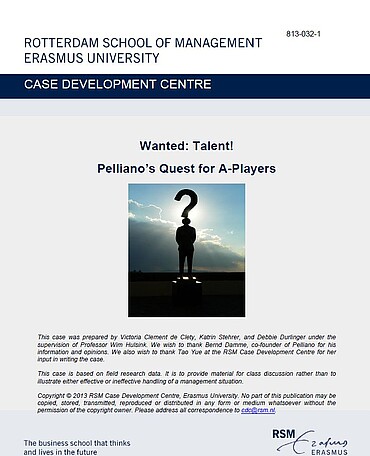Citation Note
based on Field research; 11 pages
Objective
The following learning objectives should be achieved through the exercises included in the Pelliano case: 1. Students will have developed a clear understanding of the importance of talented people within a growing company. Additionally, they should understand what is really meant by the term “A-player” and the challenges related to attracting and recruiting such A-players. 2. The case will also give students the opportunity to consider the advantages and potential drawbacks associated to having teams composed solely of A-players. 3. Finally, analysis of the case study allows students to gain further insight regarding the concept and practice of team-based entrepreneurship and the challenge of creating a corporate culture that values individual initiative while ensuring the right balance between teamwork and individual input.
description
Description: The Dutch company Pelliano aspired to become a worldwide high-quality Dutch-Italian fashion label and believed their greatest competitive advantage to do so was their employees. How could they find the talent they were looking for?
Abstract
The Dutch company Pelliano, which was launched in October 2011, aspired to become a worldwide high-quality Dutch-Italian fashion label. Pelliano initially began operating as an online business, but after a year, the company had already expanded its supply to 120 retailers in 11 countries. Only eight months after the launch, they had also expanded their product range from an exclusive focus on ties to the larger suits business. With equity capital of €380.000 and a turnover of €600.000 in 2012, the company expected to achieve capital of €2.5 million and revenues of €2 million by 2013. While dealing with fierce competition, Pelliano firmly believed its people made the difference and constituted its greatest competitive advantage. Its people were the reason for their rapid success. The initial management team, consisting of four young entrepreneurs, was supported by a range of A-player individuals, who were either young and extremely talented, or slightly older yet experienced in fashion. Pelliano had five vacancies. They needed A-players to fill these vacancies as quickly as possible in order to realize their growth aspirations. By making the use of a wide variety of recruitment methods and offering people the right incentives, the company attracted a huge pool of applicants. Despite this, the company just couldn’t find the right talent to fill their positions. How could Pelliano, as a growing start-up, have been more successful and effective in finding the talent they were looking for?
usage
Usage: As a combination of entrepreneurship and the importance of human resources, this case provides unique material for understanding the critical role of human capital in start-ups and fast-growing companies.
